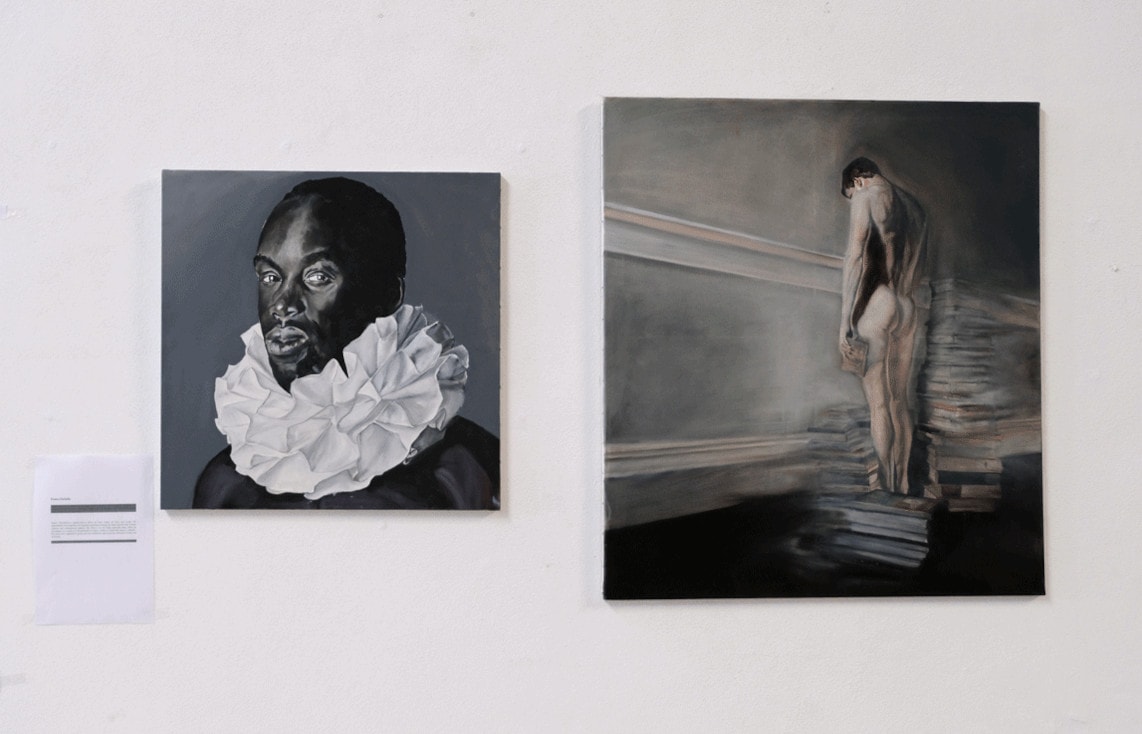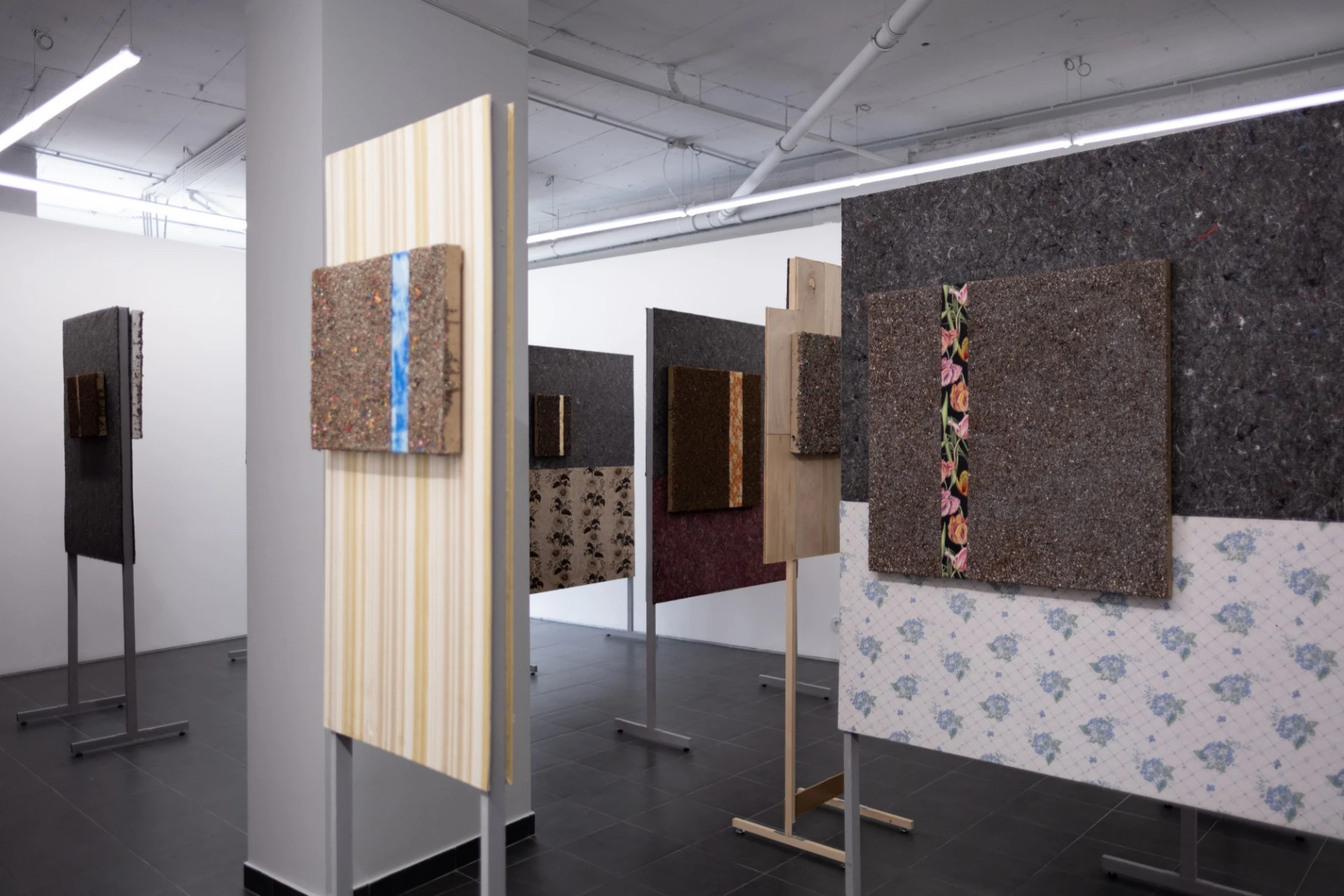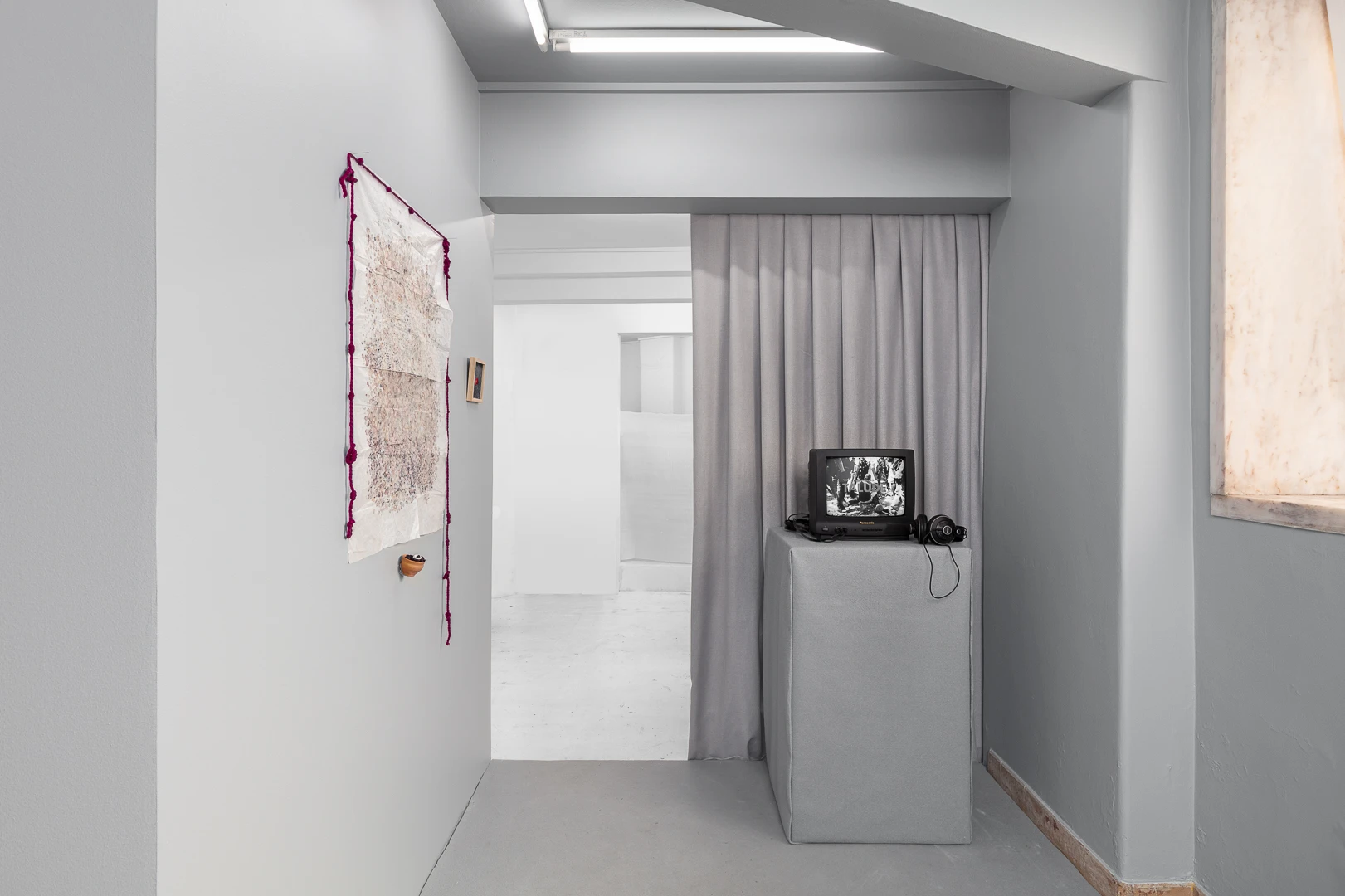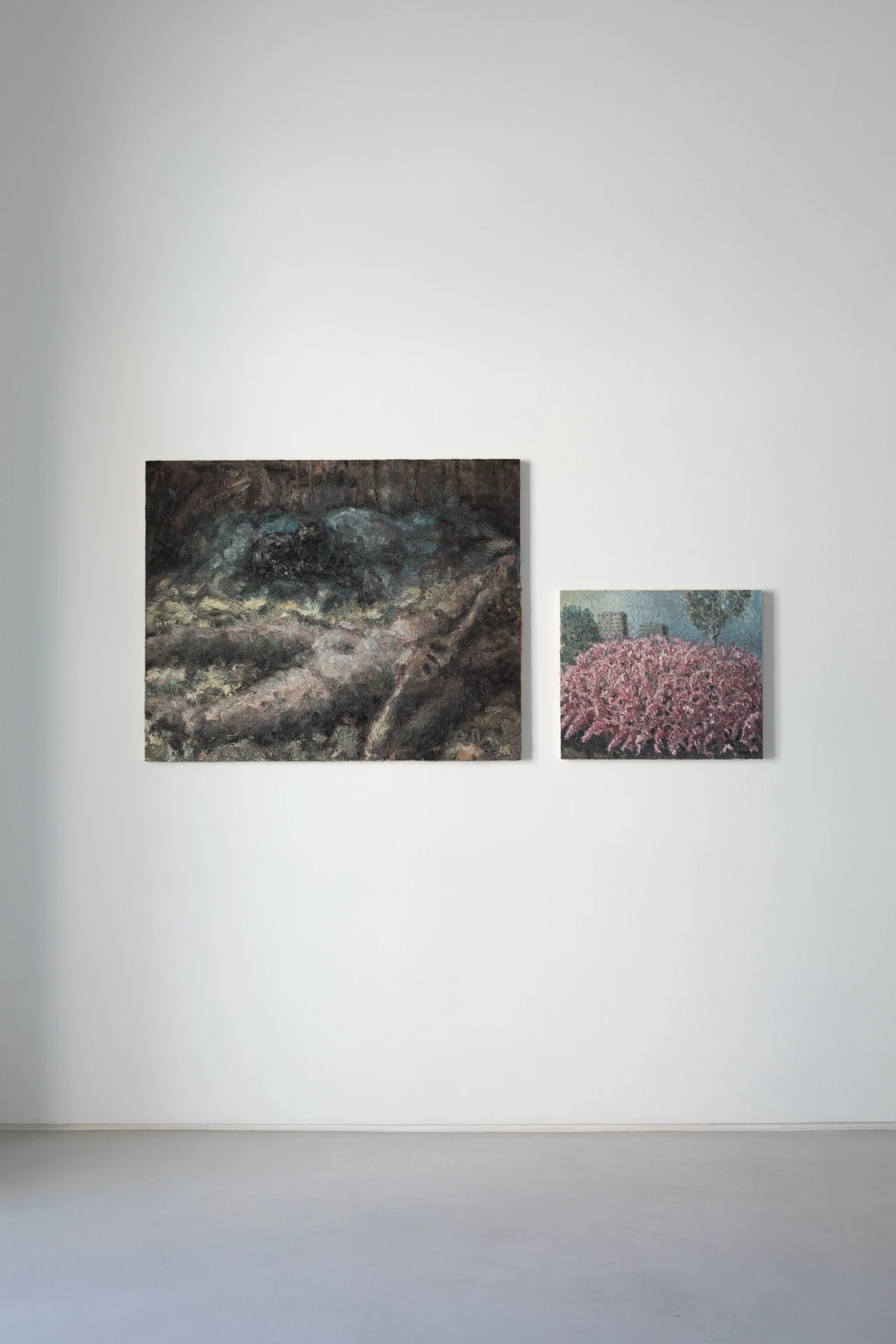In Lisbon, Carlos Nunes (São Paulo, 1969) presents two solo exhibitions that spark a speculative game with the viewer. Between sculpture, installation, drawing or engraving, the artist presents himself with careful artisanship, in an alchemical mixture of materials. ABASEDOTETODESABA at 3+1 Arte Contemporânea and Proncovô at Appleton Square complement each other. They are almost the extension of one another, allowing us to understand the manifold nature of Carlos Nunes’ work.
At 3+1 Arte Contemporânea, we immediately feel the objects’ duality. At the gallery entrance, the wind direction could be deciphered by Biruta(2022), where a rough stone block is the sculptural object’s base, and a ping-pong ball points out a possible movement. Further on, we see the work GOD DOG / DOG GOD (2021-2022), composed of three elements, a wooden matrix on which the words ‘Dog’ and ‘God’ have been engraved, and two paper prints of the first image. The transfer makes it possible to read the image correctly, which becomes accessible when passed from wood to paper, a process typical of engraving. The work is part of the palindrome series, which presents words, groups of words or numbers that are read in the same way from left to right or inversely. From this series, the artist applies the same rule to similar objects: in OMISSISSIMO (2022) the composition has two ping-pong balls with distinct colours, placed at the ends of a narrow wooden stick. Carlos Nunes makes us look at everyday words and objects in a challenging way, altering their meaning or function.
Our path is interrupted by Pipa (2022), an object in tissue paper and thread, reminiscent of kites (in Brazil, the word ‘pipa’ describes this children’s toy). With a vibrant yellow, this kite feels the breath of our body, replicating our presence with irregular movements. Immediately afterwards, a pine beam almost four metres long tries to reach the gallery ceiling. This piece gives the exhibition its name, a title that is also a palindrome. In ABASEDOTETODESABA (2022) the work is read from the bottom upwards, while the eyes try to reach the top. However, the gaze moves by instinct downwards again, back to the base lying on the ground. The beam is uniform and vertical and, if we can read it in both directions, so is the title word. If the base of the ceiling collapses, the bar seems capable of holding it up.
Before moving on to the gallery’s lower floor, Carlos Nunes presents Comprimido (2021), a series composed of twenty-two photocopies showing different compositions made with pills. The images have been arranged as a constellation, in a cluster of tablets of different colours and sizes on a black background, simulating a night sky. Our perception changes from macro to micro; we imagine micro-organisms and planetary images.
On the second floor, we see Infinito (2022), a cardboard sculpture that hides its interior. Our vision becomes anxious as we cannot observe the interior painted in black (as indicated by the work’s legend). The form is strange and walking around it is difficult due to the size of the space and work. Carlos Nunes’ speculative game grows more intense. Finally, we return to the palíndromos series with OCO (2021-2022), thirteen works aligned straight on the wall, showing different variations of the word that lends the work its title. Appealing to the geometry of the word and composition, the artist works different typographies with several colours, papers and colouring materials. The papers of different textures and chequered patterns seem torn from several notebooks, showing that the action of exploring the word has extended in time and space.
In ABASEDOTETODESABA, palindromes are the highlight, in an exhibition where contemporary art is made of everyday objects and materials.
The Pipa we saw at 3+1 Arte Contemporânea is now multiplied in Proncovô at Appleton Square, where the gallery surrenders to the kite universe. The venue looks like an open, colourful sky, willing to receive the countless messages that the artist throws into the gallery’s different corners. Proncovô, the exhibition’s title, is a typical expression from Minas Gerais, meaning “where am I going to” [1].
Thirteen works compose Proncovô, suspended from the ceiling or the wall by thin lines of vibrant colours (in green, orange, or pink). The paper kites serve as models for the compositions. Made in tissue paper, the inspiration comes from the toy’s usual structure, and the threads around the paper edges are like the work’s skeleton. The atmosphere is light and airy, and the lines grabbing the kites cross the whole area, marking the exhibition route and the position of each work. The compositions are made on coloured paper (blue, green, yellow, orange, magenta, but also black and white), composed of geometric patches, reminiscent of Josef Albers’ abstract paintings.
The kites originated in China in 1200 BC. Before becoming popular among children, this object was intended to be a military flare, exploiting movement and colour to send messages from a distance. In Proncovô, the pipas are displayed on the wall or sprouting from it, in corners, suspended from the ceiling or near the floor. Their display recalls the artist’s surroundings, who comes from a culture where kites are of great iconographic importance. In Rio de Janeiro, kites are so common in the farthest districts of the city centre that they are even responsible for power cuts, when the lines get stuck to the electricity cables.[2]
This is a flying exhibition, the works float and are sensitive to the ventilation of the space and bodies. The environment is atmospheric, light and colourful. Some lines are not attached to any kite. Suspended from the ceiling, they fall to the floor without paper support, emphasising the absence of a loose or yet-to-be-built kite. Carlos Nunes also underlines the artisanal knowledge and, again, the economy of means, using common materials to compose his own language.
In ABASEDOTETODESABA there is a dichotomy in most of the works, with several readings. The sense and meaning are constantly repositioned, altered perhaps by the speed at which the winds change direction. In Proncovô, the wind takes us to an extremely light environment, where paper kites hover in a colourful, geometric and mobile composition. In both exhibitions, the poetry of everyday life is the engine of artistic creation.
Proncovô by Carlos Nunes is at Appleton Square until October 20 and ABASEDOTETODESABA at 3+1 Arte Contemporânea until November 5, 2022.
Editor’s note: Carlos Nunes’ Abasedotetodesaba is part of an interchange protocol signed by the Portuguese gallery 3+1 Arte Contemporânea and the Brazilian gallery Raquel Arnaud. One among us, by Nuno Sousa Vieira, is the other exhibition featured in this protocol and is on show until November 4, at Gallery Raquel Arnaud, in São Paulo.
If in Abasedotetodesaba Nunes investigates the draining fragilities of present-day reality, in One among us Sousa Vieira highlights the artistic practice as something that already has in itself the roots for an equalitarian, striped-of-hierarchies experience, in which front and back, fullness and emptiness, inside and outside are the inseparable sameness of artworks and art productions – far, though, from an illustrative tendency.
[1] Information available in Proncovô’s exhibiton text.
[2] “Kites knocked out power to more than 210.000 homes in Rio de Janeiro in 2022, says concession company”. Available at: https://g1.globo.com/rj/rio-de-janeiro/noticia/2022/06/21/pipas-foram-responsaveis-pela-queda-de-energia-em-mais-de-210-mil-residencias-no-rj-em-2022.ghtml





-nwaos.jpg)